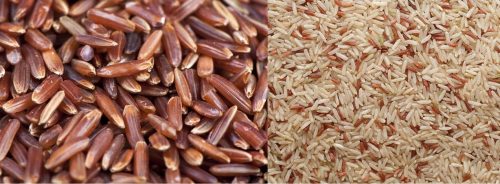 Brown rice and red rice are two popular varieties of whole grain rice known for their distinct colors, flavors, and nutritional benefits. While both types offer health advantages over refined white rice, they differ in appearance, taste, and nutrient profiles. Understanding these differences can help individuals make informed choices based on their dietary preferences and health goals. This exploration will delve into the unique characteristics of brown rice and red rice, highlighting their nutritional content, culinary uses, and potential health benefits.
Brown rice and red rice are two popular varieties of whole grain rice known for their distinct colors, flavors, and nutritional benefits. While both types offer health advantages over refined white rice, they differ in appearance, taste, and nutrient profiles. Understanding these differences can help individuals make informed choices based on their dietary preferences and health goals. This exploration will delve into the unique characteristics of brown rice and red rice, highlighting their nutritional content, culinary uses, and potential health benefits.
Let’s delve deeper into the differences between brown rice and red rice:
1. Color and Appearance:
- Brown Rice: Brown rice retains its outer bran layer, which gives it a light tan to brown color. This layer is rich in nutrients and fiber, contributing to its earthy appearance.
- Red Rice: Red rice, such as Bhutanese red rice or Camargue red rice, gets its name from its reddish-brown husk or bran layer. This coloration is due to the presence of anthocyanin pigments, which also act as antioxidants.
2. Taste and Texture:
- Brown Rice: Brown rice has a nutty flavor and a chewy texture, thanks to its intact bran and germ layers. It retains more of its natural oils compared to white rice, which enhances its taste.
- Red Rice: Red rice has a slightly nutty flavor with a more pronounced earthy taste than brown rice. It has a firm texture and remains chewy even after cooking, similar to brown rice.
3. Nutritional Profile:
- Both brown rice and red rice are considered whole grains and are nutritionally dense compared to refined white rice. Here are key nutritional aspects:
- Fiber: Both types are rich in dietary fiber, particularly insoluble fiber found in the bran layer. This fiber aids digestion, promotes satiety, and helps regulate blood sugar levels.
- Antioxidants: Red rice contains higher levels of antioxidants, primarily due to its anthocyanin content. These antioxidants help neutralize harmful free radicals in the body, potentially reducing the risk of chronic diseases.
- Vitamins and Minerals: Both varieties contain essential nutrients such as B vitamins (thiamine, niacin, and B6), iron, magnesium, and phosphorus. These nutrients support various bodily functions, including energy metabolism and bone health.
4. Glycemic Index (GI):
- Brown Rice: Brown rice generally has a lower glycemic index compared to white rice, meaning it causes a slower and more gradual rise in blood sugar levels after meals. This makes it a favorable choice for individuals managing diabetes or aiming to control blood sugar levels.
- Red Rice: Similarly, red rice also has a lower glycemic index compared to white rice, making it a suitable option for those looking to stabilize blood sugar levels.
5. Culinary Uses:
- Both brown rice and red rice are versatile in cooking and can be used in a variety of dishes:
- Brown Rice: It is commonly used in stir-fries, pilafs, salads, and as a side dish to main courses. Its hearty texture and nutty flavor complement a wide range of cuisines.
- Red Rice: Red rice is popular in Mediterranean and Asian cuisines for its distinctive color and flavor. It pairs well with vegetables, meats, seafood, and can be used in pilafs, risottos, and mixed rice dishes.
6. Health Benefits:
- Digestive Health: The high fiber content in both types of rice supports digestive health by promoting regular bowel movements and preventing constipation.
- Heart Health: The antioxidants and fiber in red and brown rice contribute to heart health by reducing cholesterol levels, inflammation, and oxidative stress in the body.
- Weight Management: Due to their fiber content, both varieties can help with weight management by promoting satiety and reducing overeating.
In conclusion, while brown rice and red rice share many similarities as whole grains with robust nutritional profiles, red rice stands out with its unique color, slightly different flavor profile, and potentially higher antioxidant content. Both types offer excellent alternatives to refined white rice, providing essential nutrients and health benefits that support overall well-being.








